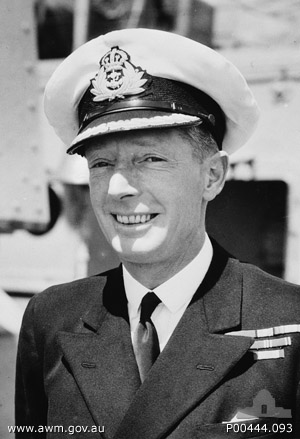
Vice Admiral Sir John Augustine Collins, was a Royal Australian Navy (RAN) officer who served in both World Wars, and who eventually rose to become a vice admiral and Chief of Naval Staff. Collins was one of the first graduates of the Royal Australian Naval College to attain flag rank. During the Second World War, he commanded the cruiser HMAS Sydney in the Mediterranean campaign. He led the Australian Naval Squadron in the Pacific theatre and was wounded in the first recorded kamikaze attack, in 1944.

Vice Admiral Christopher Angus Ritchie is a retired senior officer of the Royal Australian Navy, who served as Chief of Navy from 2002 to 2005.

Vice Admiral Russell Edward Shalders, is a retired admiral of the Royal Australian Navy (RAN). He served as Vice Chief of the Australian Defence Force from 2002 to 2005, and as Chief of Navy from 2005 to 2008.

Vice Admiral Sir Roy Russell Dowling, was a senior commander in the Royal Australian Navy (RAN). He served as Chief of Naval Staff (CNS), the RAN's highest-ranking position, from 1955 until 1959, and as Chairman of the Chiefs of Staff Committee (COSC), forerunner of the role of Australia's Chief of the Defence Force, from 1959 until 1961.
Vice Admiral Matthew John Tripovich, is a retired senior officer of the Royal Australian Navy. He served as Chief Capability Development Group from 2007 until his retirement in October 2010.
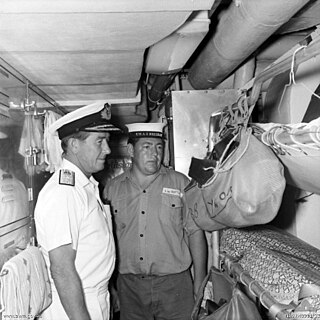
Vice Admiral Sir Hugh David Stevenson was a senior officer of the Royal Australian Navy, serving as Chief of Naval Staff from 1973 to 1976.
Rear Admiral Davyd Rhys Thomas, is a retired senior officer in the Royal Australian Navy.

Rear Admiral Nigel Stephen Coates, was a senior officer in the Royal Australian Navy.
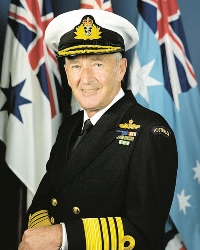
Admiral Alan Lee Beaumont, was a senior officer in the Royal Australian Navy, whose career culminated with his appointment as Chief of the Defence Force from 1993 to 1995.
Vice Admiral Rodney Graham Taylor, was a senior officer in the Royal Australian Navy, serving as Chief of Navy from 1994 to 1997. Born in Queensland, Taylor entered the Royal Australian Naval College at the age of thirteen. Graduating as dux of his year in 1957, he later specialised in navigation and served during the Vietnam War. Commanding HMAS Vampire as well as HMAS Torrens, Taylor planned and coordinated the deployment of Australian ships during the Gulf War. Retiring from the navy in 1997, Taylor died from lung cancer in 2002 at the age of 62.
Vice Admiral Sir Guido James Willis, was an officer in the Royal Australian Navy (RAN) who rose to the rank of vice admiral. He joined the RAN in 1937, saw active service during World War II and the Korean War, and was Chief of Naval Staff (CNS) from 1979 to 1982 before retiring.
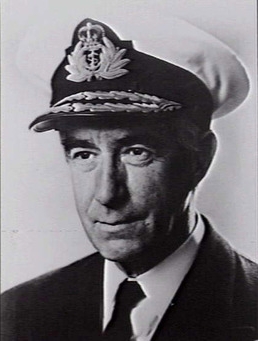
Vice Admiral Sir Richard Innes Peek was a senior officer in the Royal Australian Navy, who served as First Naval Member of the Australian Commonwealth Naval Board from 1970 to 1973.
Rear Admiral Trevor Norman Jones, is a retired senior officer in the Royal Australian Navy (RAN). He served as Deputy Chief of Navy from 2011 to 2013, Head Military Strategic Commitments from April 2013 to December 2014, and the Commander Joint Task Force 633 from December 2014 to January 2016.
Vice Admiral Raymond James Griggs, is a former Australian senior public servant and a senior officer in the Royal Australian Navy Reserve. He served as Chief of Navy from June 2011 to June 2014, before being appointed Vice Chief of the Defence Force until his transfer to the reserve in July 2018.
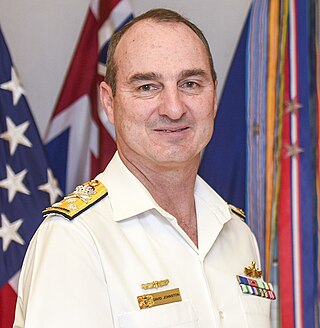
Admiral David Lance Johnston, is a senior officer in the Royal Australian Navy. He served as Deputy Commander Joint Task Force 633 on Operation Slipper in 2010, Commander Border Protection Command from 2011 to 2013 and, following promotion to vice admiral, was posted as Chief of Joint Operations from 2014 until 2018. Johnston was appointed Vice Chief of the Defence Force in July 2018. He was promoted to admiral and appointed Chief of the Defence Force on 10 July 2024.
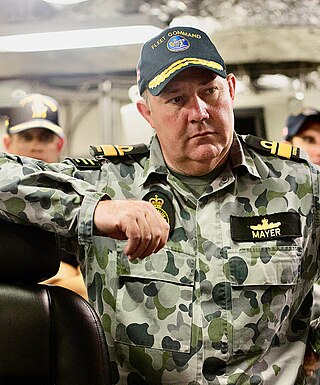
Vice Admiral Stuart Campbell Mayer, is a retired senior officer of the Royal Australian Navy. He joined the navy via the Royal Australian Naval College at HMAS Creswell in 1984 and qualified as a Principal Warfare Officer in 1994. He commanded HMAS Canberra (2002–04), HMAS Anzac (2007–09) and the International Stabilisation Force (2009–10), and deployed on operations to the Persian Gulf, East Timor, and the Arabian Sea during the Iraq War. He served as Commander Australian Fleet from 2014 to 2018, Head Force Design within the Vice Chief of Defence Force Group from 2018 to 2019, and Deputy Commander United Nations Command, based in South Korea, from 2019 to 2021. He retired from the navy in 2022 and was appointed a partner in Ernst & Young's consulting division.

Vice Admiral Ian Warren Knox, was a senior officer of the Royal Australian Navy (RAN). In a 42-year career, Knox commanded HMA Ships Torrens, Hobart and Melbourne, briefly served as Deputy Chief of Naval Staff, and was Flag Officer Commanding HM Australian Fleet from 1985 to 1987. His career culminated with his appointment as Vice Chief of the Defence Force in January 1987; a position he held until his retirement in September 1989.
Vice Admiral Robert Andrew Kevin Walls, was a senior officer of the Royal Australian Navy (RAN). In 42 years of service, Walls commanded HMA Ships Tobruk, Moreton and Brisbane, and served as Deputy Chief of Naval Staff and Maritime Commander Australia, before his career culminated in his appointment as Vice Chief of the Defence Force from April 1995 until his retirement in March 1997.

Vice Admiral Jonathan Dallas Mead, is a senior officer in the Royal Australian Navy. He joined the navy via the Royal Australian Naval College at HMAS Creswell in 1984, and spent his early career with the Clearance Diving Branch before training as a Principal Warfare Officer. He captained HMAS Parramatta on operations in the Persian Gulf from 2006 to 2007 during the Iraq War and commanded Combined Task Force 150, overseeing maritime counter-terrorism operations around the Arabian Peninsula and Horn of Africa, from 2011 to 2012. He served as Head of Navy Capability from 2015 to 2017, Commander Australian Fleet from 2018 to 2020, Chief of Joint Capabilities from 2020 to 2021, and was appointed Chief of the Nuclear-Powered Submarine Task Force in September 2021.

Vice Admiral Mark David Hammond is a senior officer in the Royal Australian Navy (RAN), serving as the Chief of Navy since July 2022. He joined the RAN as an electronics technician in 1986 and, after being accepted for officer training, graduated from the Australian Defence Force Academy in 1990. Much of Hammond's career has been spent in the Submarine Service. He has served on operations in the Indo-Pacific, commanded the Collins-class submarineHMAS Farncomb, was Deputy Chief of Navy from 2018 to 2020, and served as Commander Australian Fleet from November 2020 to June 2022. He succeeded Vice Admiral Michael Noonan as Chief of Navy on 6 July 2022.













